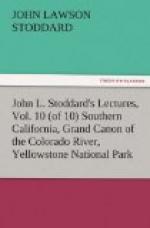The tourist comprehends the great importance of this work when he beholds the rivers of the Park threading, like avenues of silver, the sombre frame-work of the trees, and recollects that just such forests as adjoin these streams cover no less than eighty-four per cent. of its entire area. In a treeless country like Wyoming these forests are of priceless value, because of their utility in holding back, in spring, the melting snow. Some of the largest rivers of our continent are fed from the well-timbered area of the Yellowstone; and if the trees were destroyed, the enormous snowfall in the Park, unsheltered from the sun, would melt so rapidly that the swollen torrents would quickly wash away roads, bridges, and productive farms, even, far out in the adjacent country, and, subsequently, cause a serious drought for many months.
[Illustration: FIRE-HOLE RIVER.]
Another very important labor of the United States soldiers here is to preserve the game within the Park. It is the purpose of our Government to make this area a place of refuge for those animals which man’s insatiate greed has now almost destroyed. The remoteness of this lofty region, together with its mountain fastnesses, deep forests, and sequestered glens, makes it an almost perfect game-preserve. There are at present thirty thousand elk within the Park; its deer and antelopes are steadily increasing; and bears, foxes, and small game roam unmolested here. Buffaloes, however, are still few in number. They have become too valuable. A buffalo head, which formerly could be bought for a mere trifle, commands, to-day, a price of five hundred dollars. Hence, daring poachers sometimes run the risk of entering the Park in winter and destroying them.
[Illustration: MOUNTAIN SHEEP.]
It is sad to reflect how the buffaloes of this continent have been almost exterminated. As late as thirty years ago, trains often had to halt upon the prairies; and even steamboats were, occasionally, obliged to wait an hour or two in the Missouri River until enormous herds of buffalo had crossed their path. Now only about two hundred of these animals are in existence,—the sole survivors of the millions that once thundered over the western plains, and disputed with the Indians the ownership of this great continent.
[Illustration: YELLOWSTONE ELK.]
Until very recently, travelers on our prairies frequently beheld the melancholy sight of laborers gathering up the buffalo bones which lay upon the plains, like wreckage floating on the sea. Hundreds of carloads of these skeletons were shipped to factories in the east. Now, to protect the few remaining buffaloes, as well as other animals, our troops patrol the Park even in winter. The principal stations are connected by telephone, and information given thus is promptly acted on. No traveler is allowed to carry fire-arms; and any one who attempts to destroy animal life is liable to a fine of one thousand dollars, or imprisonment for two years, or both.




